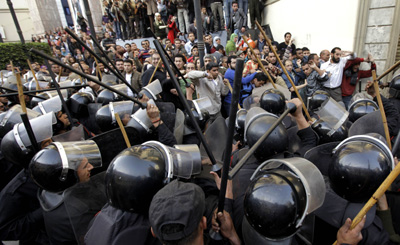What a difference a year makes. In January 2011, we had to scrap plans for our regular Middle East launch of Attacks on the Press at the headquarters of the Egyptian Journalists Syndicate in downtown Cairo. Just a few blocks away, in Tahrir Square, journalists were busy fending off their own attackers as pro-regime thugs tried to thwart young Egyptians’ ultimately successful attempt to topple Hosni Mubarak.
This year, it seemed reporters had more time and security to attend our press conference for Attacks, which chronicles many of their own travails on the road to a freer Egyptian press. Some 30 reporters climbed the gleaming black marble stairs at the imposing syndicate building, a place where many journalist demonstrations had been crushed by security forces before the revolution.
Reporters were met by my colleague, Middle East and North Africa Program Coordinator Mohamed Abdel Dayem, our host Hesham Younis of the syndicate’s foreign affairs council, and me. After the good-natured confusion and delay that seems to accompany any event in this boisterous city, we were off.
First question after a whirlwind tour of the Middle East press freedom landscape: Why is this Egyptian journalist on your imprisoned list, but not that journalist?
Answer: The list is a snapshot of those behind bars on December 1. It doesn’t record every imprisonment through the year.
Follow-up: But he’s a blogger, not a journalist.
Answer: Yes, but…
At nearly every CPJ event these days, someone asks, “Who is a journalist?” It’s inevitable given the rise of social media and universally accessible publishing platforms. It is even less surprising that the question would surface in Egypt, where mobile phones and the Internet were a foundation of the revolution. The images and voices captured in Tahrir Square by professional reporters and citizen journalists on handheld devices were played back into Egypt by mainstream satellite broadcasters. The flow of news continued even as the Mubarak government shut phone networks and hit the kill switch on the Internet.
The questioner, who was himself injured covering the Tahrir protests, smiled politely at our explanation that perhaps the real question is not “Who is a journalist?” but “What is an act of journalism?” By taking a common-sense approach to what is produced–Is it reported material? Is it fact-based commentary?–CPJ tries to embrace the ever-widening circle of people using new technology to bring us news from places where mainstream media have limited or no access.
Another question addressed a dominant theme in this year’s Attacks—censorship–but from a uniquely post-Mubarak perspective. The reporter wanted to know whether CPJ agreed that a show on state TV by a particularly vehement critic of the revolution should be censored.
Some, it seems, may still be learning that free speech cuts both ways. But the question taps into a broader, underlying concern that Egypt’s press freedom gains over the past year are not yet firmly anchored. Egyptian journalists certainly enjoy more freedom to report and criticize than they did under Mubarak. New newspaper titles and television stations have flourished, giving the public access to fresh sources of news and opinion. But the military establishment and the newly elected Islamist-majority parliament can still use an array of laws and regulations designed to rein in journalists. Efforts to reform or abolish this stifling legislative structure could take years.
The Egyptian media have taken a step on the path toward a truly free press, but the trip will be long and difficult.
(Reporting from Cairo)
